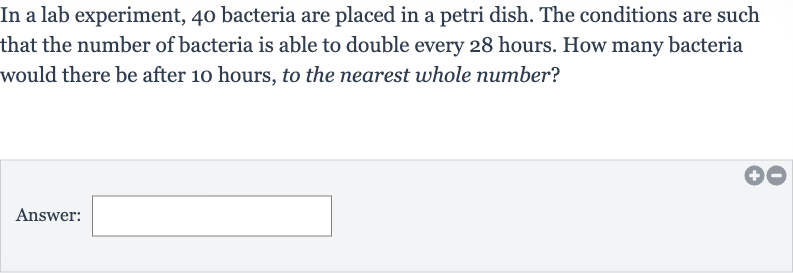AI tutor
Welcome to Bytelearn!
Let’s check out your problem:

In a lab experiment, bacteria are placed in a petri dish. The conditions are such that the number of bacteria is able to double every hours. How many bacteria would there be after hours, to the nearest whole number?Answer:
Full solution
Q. In a lab experiment, bacteria are placed in a petri dish. The conditions are such that the number of bacteria is able to double every hours. How many bacteria would there be after hours, to the nearest whole number?Answer:
- Understand and Identify: Understand the problem and determine what is given and what needs to be found.We know:Initial number of bacteria: Doubling time: hoursTime elapsed: hoursWe need to find the number of bacteria after hours.
- Calculate Doubling Periods: Calculate the number of times the bacteria population will double in hours.Since the bacteria double every hours, we need to find out how many -hour periods fit into hours. However, since hours is less than hours, the bacteria will not have doubled even once in that time frame.
- Determine Growth Rate: Determine the growth rate per hour.To find the growth rate per hour, we assume exponential growth and use the formula for exponential growth: , where is the final amount, is the initial amount, is the growth rate, and is the time in hours. Since we don't have a full doubling period, we need to solve for using the doubling time.Doubling formula: , where is the doubling time.
- Calculate Growth Rate: Calculate the growth rate . (rounded to four decimal places)
- Use Growth Rate: Use the growth rate to calculate the number of bacteria after hours.
- Evaluate Expression: Evaluate the expression to find the final number of bacteria. (using a calculator for )
- Round Final Result: Round the number of bacteria to the nearest whole number.The number of bacteria after hours, rounded to the nearest whole number, is approximately .
More problems from Convert between customary and metric systems
QuestionGet tutor help
QuestionGet tutor help
QuestionGet tutor help
QuestionGet tutor help
QuestionGet tutor help
QuestionGet tutor help
